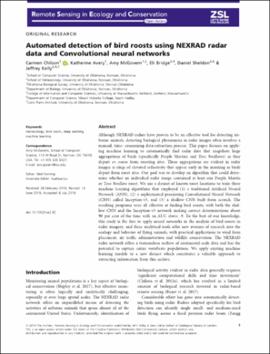| dc.contributor.author | McGovern, Amy | |
| dc.contributor.author | Chilson, Carmen | |
| dc.contributor.author | Avery, Katherine | |
| dc.contributor.author | Bridge, Eli | |
| dc.contributor.author | Sheldon, Daniel | |
| dc.contributor.author | Kelly, Jeffrey | |
| dc.date.accessioned | 2018-09-05T15:43:45Z | |
| dc.date.available | 2018-09-05T15:43:45Z | |
| dc.date.issued | 2018-08-22 | |
| dc.identifier.citation | Chilson, C. , Avery, K. , McGovern, A. , Bridge, E. , Sheldon, D. , Kelly, J. , Horning, N. and Liu, X. (2018), Automated detection of bird roosts using NEXRAD radar data and Convolutional neural networks. Remote Sens Ecol Conserv. . doi:10.1002/rse2.92 | en_US |
| dc.identifier.uri | https://hdl.handle.net/11244/301626 | |
| dc.description.abstract | Although NEXRAD radars have proven to be an effective tool for detecting airborne animals, detecting biological phenomena in radar images often involves a manual, time‐ consuming data‐extraction process. This paper focuses on applying machine learning to automatically find radar data that snapshots large aggregations of birds (specifically Purple Martins and Tree Swallows) as they depart en masse from roosting sites. These aggregations are evident in radar images as rings of elevated reflectivity that appear early in the morning as birds depart from roost sites. Our goal was to develop an algorithm that could determine whether an individual radar image contained at least one Purple Martin or Tree Swallow roost. We use a dataset of known roost locations to train three machine learning algorithms that employed (1) a traditional Artificial Neural Network (ANN), (2) a sophisticated preexisting Convolutional Neural Network (CNN) called Inception‐v3, and (3) a shallow CNN built from scratch. The resulting programs were all effective at finding bird roosts, with both the shallow CNN and the Inception‐v3 network making correct determinations about 90 per cent of the time with an AUC above .9. To the best of our knowledge, this study is the first to apply neural networks in the analysis of bird roosts in radar imagery, and these analytical tools offer new avenues of research into the ecology and behavior of flying animals, with practical applications to wind farm placement, air traffic administration and wildlife conservation. The NEXRAD radar network offers a tremendous archive of continental‐scale data and has the potential to capture entire vertebrate populations. We apply existing machine learning models to a new dataset which constitutes a valuable approach to extracting information from this archive. | en_US |
| dc.description.sponsorship | The funding from the NSF-DGE-1545261 grant helped make this research possible. We thank Sandra Pletschet for her time spent collecting the roost data and Dr. Phillip Chilson for his advice on the project. Some of the computing for this project was performed at the OU Supercomputing Center for Education & Research (OSCER) at the University of Oklahoma (OU).
Article processing charges for this publication funded in part by the University of Oklahoma Libraries Open Access Fund. | en_US |
| dc.language | en | en_US |
| dc.rights | Attribution-NonCommercial 4.0 International | * |
| dc.rights.uri | https://creativecommons.org/licenses/by-nc/4.0/ | * |
| dc.title | Automated detection of bird roosts using NEXRAD radar data and Convolutional neural networks | en_US |
| dc.type | Article | en_US |
| dc.description.peerreview | Yes | en_US |
| dc.identifier.doi | 10.1002/rse2.92 | en_US |
| ou.group | College of Engineering::School of Computer Science | en_US |

